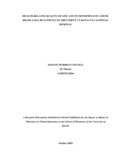| dc.contributor.author | Mutiga, Martin M | |
| dc.date.accessioned | 2019-01-29T12:33:56Z | |
| dc.date.available | 2019-01-29T12:33:56Z | |
| dc.date.issued | 2018 | |
| dc.identifier.uri | http://hdl.handle.net/11295/105882 | |
| dc.description.abstract | Background: Heart failure (HF) is a debilitating chronic condition that adversely affects the Health- related quality of life (HRQoL), an important outcome in HF management. HRQoL is a multidimensional construct of well-being affected by the physical, mental, emotional, and social status of the patients. The ability to identify the predictors of HRQoL among patients with HF is crucial in improving clinical care and determining targets of intervention for the prevention and treatment of the condition.
Objective: The aim of this study was to determine the HRQoL and identify its determinants among heart failure patients attending the Cardiac clinic at the Kenyatta National Hospital (KNH).
Methods: A cross-sectional study was conducted to determine HRQoL of patients with HF. A total of 109 patients were recruited into the study via a consecutive sampling. The HRQoL was measured using the generic tool, WHOQOL-BREF. Both descriptive and inferential statistics were employed. Socio-demographic and clinical variables were used as explanatory variables in both the Bivariate and Multivariate linear regression analysis to identify the predictors with the level of significance set at p = < 0.05.
Results: Patients were predominantly females (66.1%), had a mean age of 55.3 ± 17.0 years. The etiologies of HF were identified as hypertension (40.4%), cardiomyopathy (39.5%), and Rheumatic heart disease (23.9%) among others. The major comorbidities were hypertension (48.6%), valvular heart disease (45.0%) and atrial fibrillation (12.8%). The common classes of drugs used were ACEIs/ARBs, β-blockers, diuretics, Aldosterone Receptor Antagonists (ARAs), and cardiac glycosides. In linear regression analysis, higher NYHA grading, lower education level, lower age and no Beta-blocker prescription were identified as significant factors associated with poor HRQoL.
Conclusion: NYHA functional class was the most important predictor of HRQoL. Interventions targeted to improve the physical symptoms would therefore improve HRQoL.
Recommendations: For early diagnosis and treatment of HF and the primary cardiac conditions as well as the assessment of the prevalence and causes of cardiomyopathy among the heart failure patients at Kenyatta National Hospital | en_US |
| dc.language.iso | en | en_US |
| dc.publisher | University of Nairobi | en_US |
| dc.rights | Attribution-NonCommercial-NoDerivs 3.0 United States | * |
| dc.rights.uri | http://creativecommons.org/licenses/by-nc-nd/3.0/us/ | * |
| dc.title | Health-related Quality of Life and Its Determinants Among Heart Failure Patients on Treatment at Kenyatta National Hospital | en_US |
| dc.type | Thesis | en_US |
| dc.description.department | a
Department of Psychiatry, University of Nairobi, ; bDepartment of Mental Health, School of Medicine,
Moi University, Eldoret, Kenya | |



